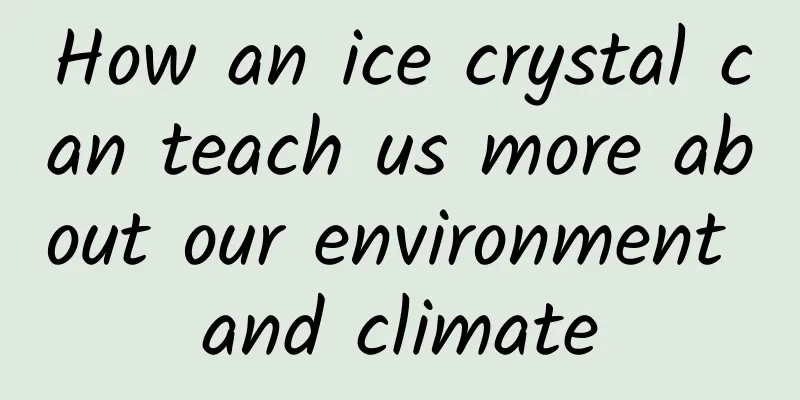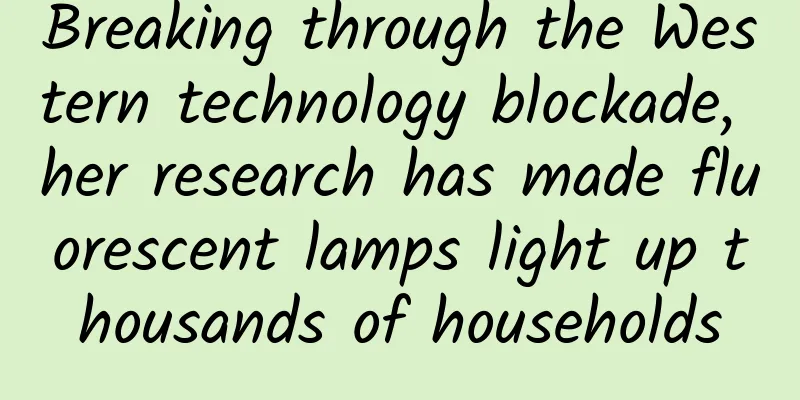How an ice crystal can teach us more about our environment and climate

|
When a fluffy, soft cloud appears on the horizon, no one can resist picking up their phone to record this moment; when the sky is covered with dark clouds, we know that a rainstorm is about to come. From childhood experience, we know that rain falls from clouds, but do you know what in the clouds turns into rain? The accumulation of fog droplets and the transmission of light form dark clouds (Image source: Wikipedia) Clouds are a collection of a large number of tiny water droplets and ice crystals suspended in the air. Although clouds are made of water, water droplets have surface tension and are difficult to grow larger, so it is difficult for them to fall from the clouds. Even larger water droplets will quickly evaporate and turn into water vapor after falling out of the clouds, and then return to the clouds. Compared with water droplets, ice crystals are more likely to escape from the clouds, fall to the ground, and form precipitation. Therefore, the formation of ice crystals is crucial to precipitation. How are ice crystals formed? When we only see the beautiful appearance of ice crystals, what kind of reactions are happening inside them? 1. How are beautiful ice crystals formed? It may be difficult to observe with the naked eye, but ice crystals under a microscope are indeed very delicate and beautiful. Generally speaking, ice crystals can be formed in two ways: one is that water droplets or cloud droplets directly form ice crystals; the other is that water vapor or supercooled water droplets condense or freeze under the action of particles to form ice crystals. The key substance that can trigger the formation of ice crystals is ice nucleus particles. Ice crystals in the atmosphere (Image source: snowcrystals) Generally speaking, the first pathway requires the temperature to be below -38 degrees Celsius, which is difficult to achieve under actual atmospheric conditions. Therefore, ice crystals are generally formed through the second pathway, that is, with the help of ice nucleus particles. What kind of particles can serve as ice nuclei? In fact, dust, bacteria, and even pollen floating in the air are all ice nuclei with very strong ice nuclei activity. The dust we are talking about here mainly refers to mineral particles, which are considered to be one of the most important ice nuclei in the atmosphere. 2. Mineral particles and heterogeneous reactions Mineral particles emitted into the atmosphere from arid and semi-arid regions have a significant impact on air pollution, human health and climate change. When mineral particles float in the atmosphere, they are very easy to absorb and react with pollutants in the atmosphere due to their large surface area. The reaction process of this gas on the surface of particles is called heterogeneous reaction. Current research shows that heterogeneous reactions of mineral particles with nitrogen dioxide play an important role in the removal of nitrogen oxides and the formation of ozone and nitrates, which significantly affect air quality. However, we do not yet know what effect heterogeneous reactions of nitrogen dioxide have on the ice nucleation activity of mineral particles. Sandstorms: severe air pollution events caused by mineral particles (Image source: Wikipedia) To investigate this question, we developed a method to measure the ice nucleation activity of atmospheric particles (Guangzhou Institute of Geochemistry Ice Nucleation Apparatus, GIGINA) and applied this method to investigate the effects of the heterogeneous phase response of NO2 on the ice nucleation activity of mineral particles. The mineral particles we selected are potassium feldspar and Arizona dust. Potassium feldspar is currently considered to be a mineral particle with strong ice nucleation activity, while Arizona dust is a substitute for natural dust particles. It is widely used internationally because of its known particle size distribution, mineral composition and easy acquisition methods. Effects of the heterogeneous phase response of nitrogen dioxide on ice nucleation activity of mineral particles (Image source: self-made by the author) We found that the heterogeneous reaction of nitrogen dioxide can significantly reduce the ice nucleation activity of feldspar and Arizona dust. Specifically, during the reaction period of 0 to 6 hours, the nitrate content generated by the heterogeneous reaction on the surface of feldspar particles gradually increased with the increase of reaction time; at the same time, the ice nucleation activity of feldspar gradually decreased with the increase of reaction time. However, when the reaction time was further extended to 24 hours, the nitrate content and ice nucleation activity of feldspar did not change significantly. For Arizona dust, we found that the nitrate content of Arizona dust gradually increased with the reaction time from 0 to 24 hours, while its ice nucleation activity gradually decreased. In addition, we also found that the inhomogeneous phase response of nitrogen dioxide had significant differences in the effects on feldspar and Arizona dust. 3. Who affects the ice nucleation activity of mineral particles? How does the heterogeneous reaction of nitrogen dioxide reduce the ice nucleation activity of these two mineral particles? To answer this question, we need to understand what special properties make mineral particles have strong ice nucleation activity. Current research has found that the surface properties of mineral particles, such as surface morphology, lattice structure, and surface functional groups, are closely related to the ice nucleation activity of particles. For example, a study published in Science found that ice crystal formation usually occurs at defects and cracks on the surface of mineral particles. Due to the lack of knowledge about the ice formation mechanism of mineral particles, we cannot accurately answer why heterogeneous reactions can reduce the ice nucleation activity of mineral particles. However, here, we try to propose the following mechanism to explain: During the heterogeneous reaction, nitrogen dioxide will react with the surface of mineral particles, replacing potassium, sodium, and aluminum in the lattice structure of mineral particles, thereby changing the lattice structure of mineral particles and reducing their ice nucleation activity. On the other hand, heterogeneous reactions will change the hydroxyl functional groups on the surface of particles, thereby affecting the surface properties of particles and reducing their ice nucleation activity. To date, scientists still cannot perfectly answer the microscopic physical process of ice crystal formation in the atmosphere and its influencing factors, but continuing to explore these issues will play an important role in our future understanding of the environmental and climate effects of atmospheric particulate matter. Produced by: Science Popularization China Produced by: Chen Lan, Xia Di, Tang Mingjin (Guangzhou Institute of Geochemistry, Chinese Academy of Sciences) Producer: China Science Expo |
<<: Suitcases "fall from the sky"! Don't do this, it's too dangerous!
>>: God opened a window for you, but you installed iron bars!
Recommend
The dead branches and leaves under your feet actually hide the big secret of global change!
Produced by: Science Popularization China Author:...
Successfully launched! All members of Gaofen-3 have assembled!
The reporter learned from the National Space Admi...
I start drooling when I pass by a bakery. Is that tempting aroma fake?
Whenever I pass by a bakery, I always smell a fra...
The WeChat Moments comment emoticon function has been closed after being removed from the shelves 2 days after its launch
On December 25, after some netizens broke the new...
How to build your first machine learning model on your iPhone
introduction As a data scientist, I have always h...
APP campus promotion: the current campus promotion market is divided into four parts
From the time when " Xiaonei.com " bega...
How to improve user registration conversion and user activation
User registration conversion and user activation ...
Do you want to slap a mosquito to death? Dinosaurs may have thought so too
Mosquitoes have a way of ruining our mood every s...
Are you a master programmer or a novice programmer?
[[131541]] "Rookie" and "Master&qu...
Seeding + live streaming, a complete guide to playing Douyin on Double Eleven
The annual Double Eleven Carnival is about to beg...
Aiti Tribe Story Collection (11): Programming from 0 to 1
[51CTO.com original article] Aris became interest...
What is the upper stage of a rocket? Is it on top of the rocket? Click here to learn more about the "space shuttle"
The rocket upper stage is a device we often hear ...
From the popularity of Fenda, let’s look at the operations behind it!
Recently, Fenda has become very popular on WeChat...
Visual Studio 2015 will be released on July 20
[[138348]] Microsoft has announced that the offic...
The rise of the Internet of Things, can it really make life better?
According to foreign media reports on June 14, th...









